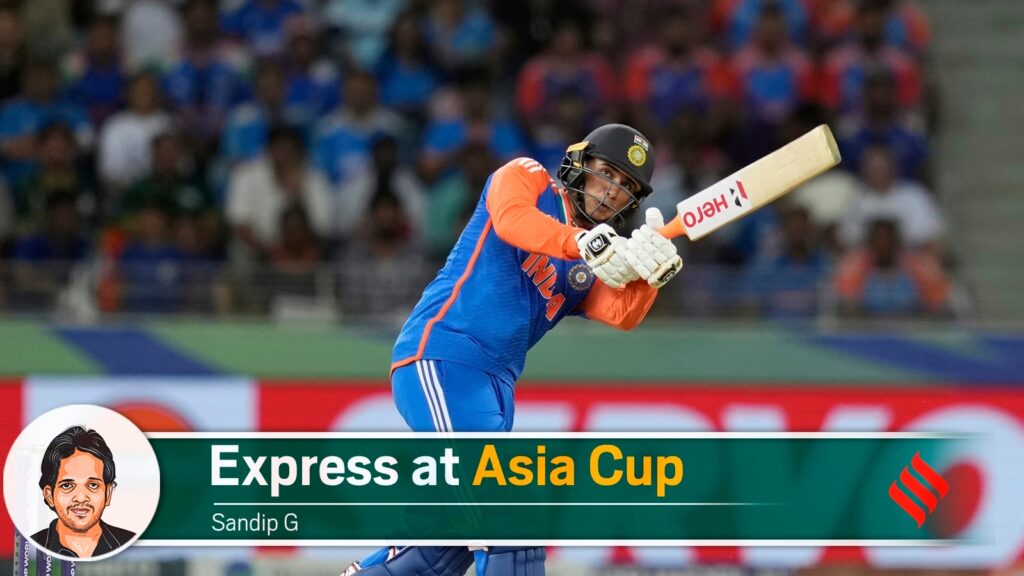From the distant perch for the media at the leafy ICC Cricket Academy ground, its setting a slice of the English county ground with picket fence and miniature Victorian buildings in the backdrop, the batsmen in the nets at the far end seem like flickering silhouettes when the dusk sinks in. The identification goes by a quirk in the batting stance, the peculiar sound of the willow when they sweet-spot, or the routes they take. The easiest to identify is Abhishek Sharma, not only because of his lean frame, angular, stork-like stance, with well-defined geometry, but he hits the ball the farthest, the furthest and the most frequent.
When batsmen take the aerial route in the nets, screams of “watch it” can be frequently heard. But a support staff member was overheard telling the other. “Usko tension nahin hain, who hamesha ground ke baahar bhejte hain!” (No need to be wary when he bats, he usually hits the ball out of the ground). Net bowlers will have to frequently re-stock the supply of cricket balls because some are lost in the garden nearby, some deposited on the pocket road. Between strokes, his laughter echoes, especially when his friend from childhood Shubman Gill is on the adjoining nets, or Tilak Varma. He is a young cricketer fully enjoying his rosy form.
It’s also when he doubles up on his practice. “It’s a piece of advice that I got from Brian Lara (his mentor at Sunrisers Hyderabad). He told me “when you are in good form, double up your practice, because you will always be in the bowlers’ mind. They would be planning for you, and coming extra hard at you. So you should be even better prepared”,he once said in an interview on SRH website. Lara, one of his idols, is a guiding light for him. It’s a common sight to spot the West Indies legend standing behind him when he is batting in the nets of Sunrisers. “He doesn’t talk much technical stuff, that Yuvi paaji (Yuvraj Singh) does, but more like telling me, you could target this area, or that area”.
His fluid bat-swing has been likened to Lara. He demurs, when such comparisons are put across him. “He is a legend…” he pauses in the interview. The implication is he himself has not reached the status of a legend and hence can’t be compared. It didn’t escape the eyes of Lara’s fellow great, Sachin Tendulkar. “His bat swing is effortless. He generates an incredible amount of power. It may not be too visible – he is not a big guy – but he has such sweet timing. I love watching him. The way he plays, hits sixes and fours to all parts of the ground. It’s a joy to watch,” Tendulkar said in an interaction with Star Sports.
Abhishek has smoothly established himself as the heartbeat of India’s daring approach, as vital as Ben Duckett to the Bazball cause, or as central as Sanath Jayasuriya to Sri Lanka’s 15-over-blast doctrine in their victorious 1996 World Cup.
He is India’s tempo-setter, the heavy guitar riffs that start off a heavy metal concert. Last game, he seized the momentum with his first two strokes. The first ball, he almost roller-skated down the track and biffed Shaheen Afridi, one of the most feared new-ball bowlers, down the ground for a four. The next ball, he scythed him over extra cover. Such momentum is hard to stop, and Pakistan never recovered from the blows. Abhishek perished for 31 off 13 balls, but these are knocks more valuable than a half-century at a slower pace. His strike rate of 195.40 in 18 innings is the reason India’s relentless aggression works. That he averages 33.11, despite the hyper-aggressive approach, explains his value to the team. He hits a six in every seventh ball; a four every sixth delivery. It means every third ball is a hit to the fence or over it. He balances both without embracing a high-risk approach either, sticking to his percentage strokes.
His batting could seem all fun and frolics, a player who seemingly feeds on vibes. But there is a cold-eyed sniper-like dissection about him. Every stroke is well thought out and finessed. The mechanics are simple. There is no exaggerated trigger movement, long and definite strides and an uncluttered bat-swing, like the swish from a Samurai’s sword. The risk is minimal–even though it does not mean he is entirely risk-proof. He stepped out to Afridi first ball because his initial deliveries would invariably be full. The flow of boundaries is unstoppable; when he can’t find the fence, he rotates the strike with brisk singles. He is not content with merely flashy useful starts for the team. He has an eye for big scores too. Four fifty-plus scores–two of those hundreds–are incredible for someone of his hyper-aggressive disposition.
Story continues below this ad
It was Lara who instructed him on the importance of big scores. He told former cricketer Aakash Chopra in an interview: “One day Lara sir brought a list of the all openers in all the franchises. All big names, like Jonny Bairstow, Jos Buttler, David Warner…etc. He asked me the common factor that binds them all. I didn’t give a clear answer, and he told me, they all face around 35-40 balls a game. And that’s all they need to change a game. He told me that I should aim for that as well.”
Only twice has he managed that in his still-nascent T20I career. Both ended in hundreds. “I surely want to bat as long as possible,” he recently said. Bowlers would pray such a day as this would not arrive.


